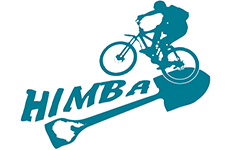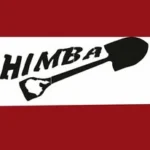One of HIMBA’s main purposes for existing is to help maintain the trails of Hornby Island via activities coordinated by our Trailwork Committee. However, we do not do this work alone. The Comox Valley Regional District is the land manager for a significant portion of the public lands and parks on Hornby, and they have a locally contracted maintenance person. HIMBA works within the parameters established by the CVRD, and the CVRD must first authorize any major work we undertake.
A local committee advises the CVRD, called the Parks & Trails Committee. This group is made up of trail users and HIMBA has two representatives on the committee.
Our efforts are mainly volunteer-based, but we do spend on equipment purchases and rentals as well as countless free lunches, beverages, and occasional social gatherings for volunteers. We are self-funded through the sale of our trail maps, available at the Bike Shop and Co-op Gas Bar.
Trail Projects
our trail projects have become too numerous to name but check out our Instagram feed below to see what we have been up to lately.
Old Projects:
BikeFest Dual Clearing 2017
TIme: 40+ Hours Resources: Hand tools and brush cutters.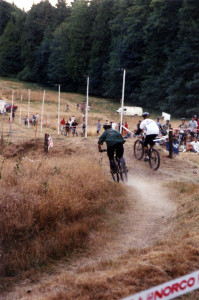
The Project
First constructed in the fall of 1992, the Bikefest Dual is an exciting dual-run down a one and a half minute course. The track starts out on a steep hillside in the woods, then bursts out into the clearing for a wild run down a BMX style banked track with several jumps. It then separates out into a 100 metre two track slalom course and finishes at the base of the hill.
Work Done:
Every spring the course needs to be mowed and spiffed up. In 2017 we did that, as well as re-routed some watercourses that were running down the track.
Dylan’s Drop
TIme: 100+ Hou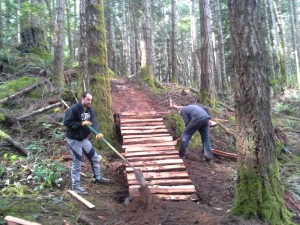
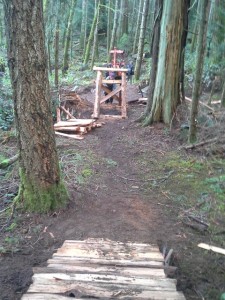 rs Resources: Split cedar ramps & box culvert.
rs Resources: Split cedar ramps & box culvert.
The Project
In honour of Dylan Holliday, we undertook a revision of an existing section of trail that comes off of Yer Mom. This little spur trail near the bottom of the Yer Mom leads to a jump that crosses Washing Machine trail.
Work Done:
We reworked the approach trail to be sustainable and provide a smoother approach to the main jump over Washing Machine. This jump is now a constructed cedar ramp with a take-off height of over six feet. The landing area has been cleared and buffed. It now includes a ride-out trail onto Coltsfoot. The jump has been tried and all agree that it is one of the biggest on Hornby.
Update from Tom Rutherford March 14, 2015: With 9 or 10 sets of hands on deck, the work on the lower part below jump landing was completed before 1 pm, hampered somewhat by the muddy conditions thanks to all night rain. So lower part is connected with a big berm and cedar bridge onto Coltsfoot. Excavation holes were nicely covered up and many ferns replanted here and there. However, until muddy sections dry out it is not rideable and more material may have to be brought in after it all settles. Later in the afternoon, a few hardcores gathered to face the challenge. Fearless Case led the way and nailed the jump twice with the report that “surprisingly, it all worked”. Jody was next and treated onlookers Case, Nigel and Dad to a spectacular overshoot. He couldn’t hold the landing (approaching the bottom flats) and ended up in a tangle of bike and mud and thankfully no injuries. I’m not sure if anyone else took a stab at it later on. Landing could use some drying out as its pretty soft. All for now.
No Horses Upgrades
Time: 60 man-hours Resources: two cedar box culverts.
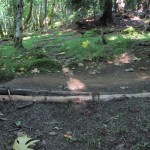 The Project:
The Project:
Over the years No-Horses has evolved into one of the Island’s most popular trails. It is unique in that it runs in and out of a seasonal creek bed, and while this makes for exciting riding it does create water-crossing problems with each dip. As well, in the past, a couple of well-intended upgrades were undertaken that have since proven to be unsustainable or to interfere with the flow of the original trail.
Work Done:
Over the past year, we have been working to upgrade all of the water crossings on No Horses. We have been systematically replacing old style wet crossings with bridges, box culverts and French Drains. This year we placed two new box culverts, re-graded several sections to encourage sheet-flow of water and conducted a major rework of one of the corners that had been previously modified in what turned out to be an undesirable manner.
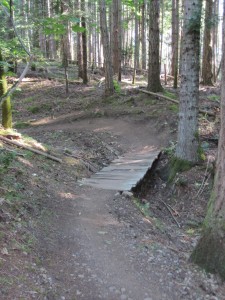
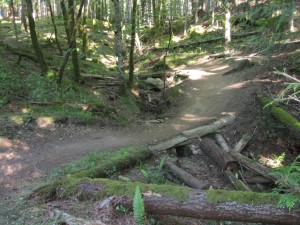 One of the box culverts placed was of an experimental nature: instead of being assembled from cedar planks we found a cedar log that had been hollowed out into a “U” shaped channel. We were curious to see if this type of culvert could work as there are many of these types of cedar logs on the ground out in the wood. As of the time of writing the log culvert has been in use for four years and continues to perform well.
One of the box culverts placed was of an experimental nature: instead of being assembled from cedar planks we found a cedar log that had been hollowed out into a “U” shaped channel. We were curious to see if this type of culvert could work as there are many of these types of cedar logs on the ground out in the wood. As of the time of writing the log culvert has been in use for four years and continues to perform well.
Beaverslide Restoration
Time: 8 hours of machine time & 32 man-hours
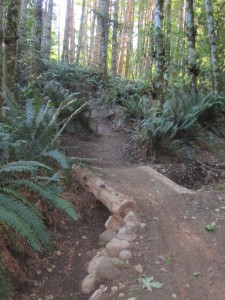
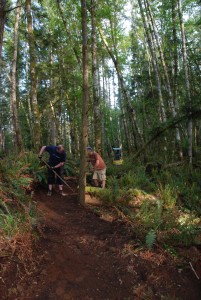
The Project:
Beaver Slide was originally a logging road that was re-opened by Leigh Cross in 1978 with a team of Percheron Horses. As he had no problem with traction, when he had to make a decision about routing he chose to go straight up the hillside. This routing survived for 30 years but in the last decade, the fall-line nature of the trail led to erosion caused by usage and water running down the trail. The past five years have seen particularly rapid erosion that left portions of the trial unusable.
Work Done:
After consultations with the Parks Maintenence Contractor, Yana Pethick, it was decided that a completely new section of trail should be build that was away from the water flow and that allowed for a sustainable trail slope. A dry ridge to the right of the old trailbed was located and a route pin flagged. The pin flagging process worked particularly well as it allowed the proposed route to be demarcated by a small group as time permitted and then reviewed over a period of several days by other interested parties as they had time to get to the site. The variety of points of view and subsequent fine-tuning of the route resulted in a very well received trail that is well suited to all forms of traffic and skill levels.
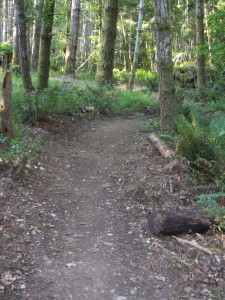
The Beaver Slide restoration also provided a chance to test the use of a small tracked Yanmar excavator in the trail-building process. This Machine has a 36-inch blade and small hoe. The resulting trail is 36 inches wide when fresh but on Hornby, we expect that in a year or two the trail will narrow to the ridden/walked width of about 18 inches due to the rapid growth of mosses and other ground covers. (Editors note from four years later: The trailbed did perform as expected, it has narrowed to about 24 inches wide and is holding up well to heavy traffic).
We observed that the machine could do a tremendous amount of work and with a skilled operator at the controls the resulting trailbed retained many of the natural contours that make for interesting trail riding. From an efficiency point of view, the excavator was invaluable; As a group, HIMBA is able to raise significant funds and we are always searching for the best way to turn those funds into trails. As our volunteer man-hours are limited we found that putting funds toward machine time was one of the best ways to use our financial and volunteer resources to create trails.
Genuine Draft Restoration
Time: 8 hours of machine time & 60 man-hours
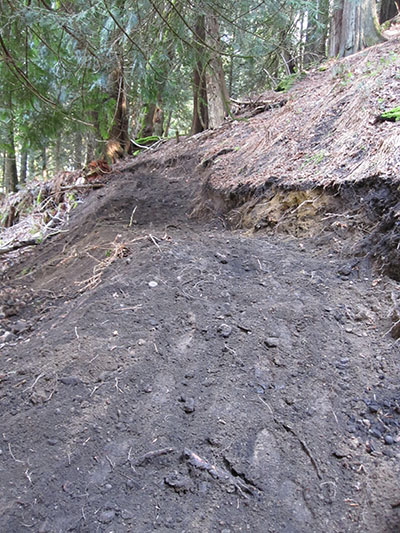
The Project:
Genuine Draft trail was built in 1991 to allow the Cross Country racecourse for the Hornby Island Mountain Bike Festival to begin and end in Strachan valley. It runs from an old irrigation pond on the Cross Farm to Beaver Slide Trail. As it passes through private land it was left fallow after the racing activities shut down in 2001. in 2011 HIMBA, after permission was obtained from the landowners, revived Genuine Draft trail.
Work Done:
As the trail passes through private land it presented an opportunity to test some of our theories about side-hill trail construction using the Yanmar tracked excavator. We felt that the earth moving ability of the Yanmar would allow us to make a wide, well-graded trailbed on steep side-hill terrain without using any wooden berm supports, and was the best use of our available cash and limited volunteer time. The new trail followed about half of the old route with one major diversion to avoid an unsustainable slope. The total length of trail built is about 2 kilometres and the excavator proved to be invaluable in the process as it allowed us to make a proper width trailbed with 100% mineral soil, a key factor in trail sustainability. The trail was completed in record time and has proven to be an excellent walking and jogging route as well as a joy to ride.
